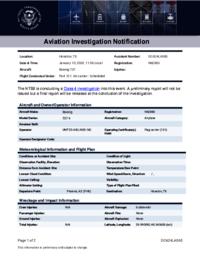
This information is added by users of ASN. Neither ASN nor the Flight Safety Foundation are responsible for the completeness or correctness of this information.
If you feel this information is incomplete or incorrect, you can submit corrected information.
| Date: | Wednesday 10 January 2024 |
| Time: | 10:10 |
| Type: |  Boeing 737-924ER (WL) |
| Owner/operator: | United Airlines |
| Registration: | N62883 |
| MSN: | 42202/5463 |
| Year of manufacture: | 2015 |
| Total airframe hrs: | 27865 hours |
| Cycles: | 10115 flights |
| Fatalities: | Fatalities: 0 / Occupants: 185 |
| Other fatalities: | 0 |
| Aircraft damage: | Substantial |
| Category: | Accident |
| Location: | Houston-George Bush Intercontinental Airport (IAH/KIAH), Houston, TX -
 United States of America United States of America
|
| Phase: | Landing |
| Nature: | Passenger - Scheduled |
| Departure airport: | Phoenix-Sky Harbor International Airport, AZ (PHX/KPHX) |
| Houston-George Bush Intercontinental Airport, TX (IAH/KIAH) | |
| Investigating agency: | NTSB |
| Confidence Rating: |
United Airlines flight 2498 experienced a tail strike while landing at George Bush Houston Intercontinental Airport (IAH), Houston, Texas. The flight was a regularly scheduled domestic passenger flight from Phoenix Sky Harbor Airport (PHX), Phoenix, Arizona to IAH.
The flight crew statements and flight data showed a stable approach to the landing flare. The first officer was pilot flying and stated he began the flare slightly late. Both crewmembers stated the touchdown was firm with a slight “nose-high” bounce. The flight crew was not aware the airplane’s tail had impacted the runway until the ground crew at the gate notified them.
Flight data showed that the airplane touched down on the runway with a 6.5-degree nose-up attitude and vertical acceleration of 1.87g. The speed brakes deployed two seconds after the initial touchdown. At the same time, the aircraft became airborne again and the nose began to lower. Two seconds later, as the speed brakes retracted, the airplane’s pitch began to increase, and the airplane touched down a second time with pitch of 7.2 degrees and a vertical acceleration of about 2.87g. The airplane became airborne for a 3rd time for about a second before it touched down for the final time. The nose was lowered to the ground, and speed brakes were extended again.
Post-accident assessment of the aircraft revealed substantial damage to the auxiliary power unit (APU) firewall bulkhead that occurred as a result of the aircraft’s aft fuselage’s contact with the runway.
Probable Cause: The airplane’s aft fuselage impacted the runway as a result of a delayed flare and subsequent nose-high pitch inputs during the aircraft’s multiple touchdowns.
METAR:
Weather about the incident time (1610Z):
KIAH 101553Z 16009KT 10SM FEW150 SCT250 13/01 A2996 RMK AO2 SLP145 T01280011
KIAH 101653Z 18009KT 10SM FEW250 17/03 A2995 RMK AO2 SLP142 T01670028
Accident investigation:
 |
|
Sources:
NTSB DCA24LA065
https://data.ntsb.gov/Docket?ProjectID=193637
Location
Revision history:
| Date/time | Contributor | Updates |
|---|---|---|
| 20-Jan-2024 19:54 | harro | Added |
| 08-Feb-2024 19:50 | Captain Adam | Updated [Time, Damage, Category, Accident report] |
| 04-May-2024 17:30 | ASN | Updated [Narrative] |
| 18-May-2024 19:24 | Captain Adam | Updated [Time, Total occupants, Location, Source, Narrative] |
Corrections or additions? ... Edit this accident description
The Aviation Safety Network is an exclusive service provided by:


 ©2024 Flight Safety Foundation
©2024 Flight Safety Foundation